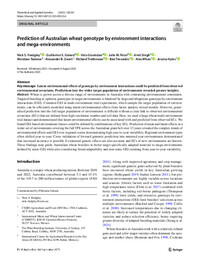Prediction of Australian wheat genotype by environment interactions and mega‑environments

Authors:
Key message
Latent environmental effects of genotype by environment interactions could be predicted from observed environmental covariates. Predictions into the wider target population of environments revealed greater insights.
Abstract
Wheat is grown across a diverse range of environments in Australia with contrasting environmental constraints. Targeted breeding to optimise genotypes in target environments is hindered by large and ubiquitous genotype by environment interactions (GEI). Common GEI in multi-environment trial experiments, which sample the target population of environments, can be efficiently modelled using latent environmental effects from factor analytic mixed models. However, generalised prediction into the full target population of environments is difficult without a clear link to observed environmental covariates (ECs) that are defined from high-resolution weather and soil data. Here, we used a large wheat multi-environment trial dataset and demonstrated that latent environmental effects can be associated with and predicted from observed ECs. We found GEI-based environment classes could be defined by combinations of key ECs. Prediction of main and latent effects in a wider set of environments covering the full TPE across the Australian grain belt over 13 years revealed the complex trends of environmental effects and GEI over regional scales demonstrating high year-to-year variability. Regional environment types often shifted year-to-year. Cross-validation of forward genomic prediction into untested year environments demonstrated that increased accuracy is possible if estimated genetic effects are also accurate and ECs of new environments are known. These findings may guide Australian wheat breeders to better target specifically adapted material to mega-environments defined by static GEI while also considering broad adaptability and non-static GEI resulting from year-to-year variability.
